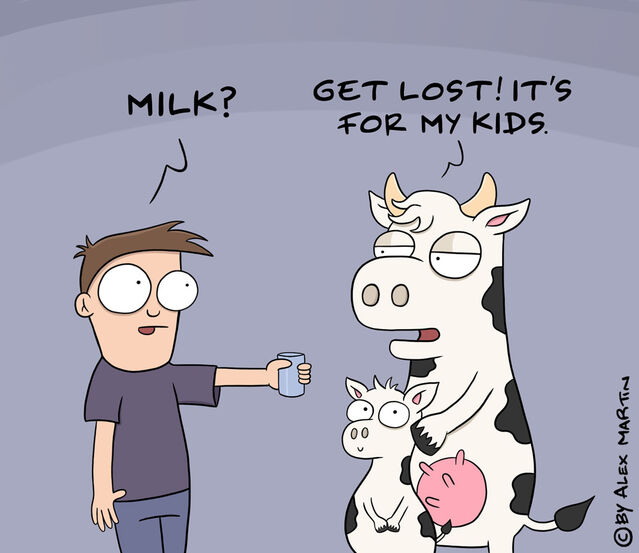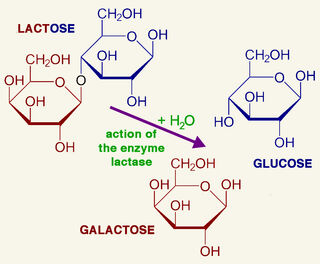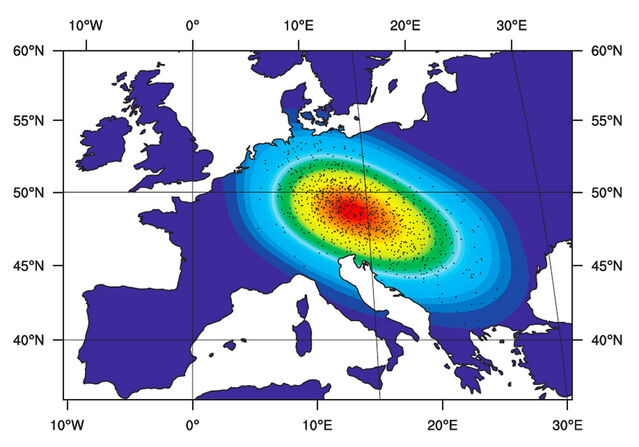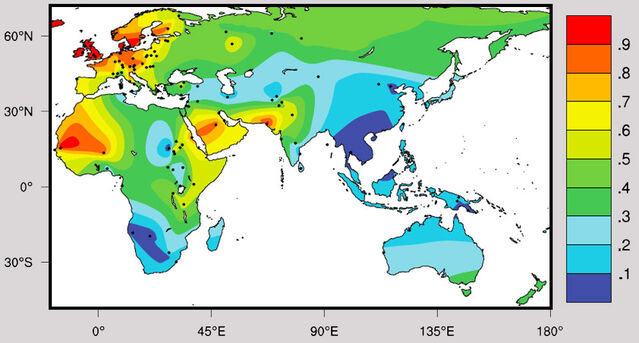Genetics
Lactose Intolerance: When Milk Makes You Sick
How people began to tolerate lactose in milk products from farming.
Posted June 28, 2020

Suckling of infants is universal among mammals, which are after all named after the Latin mamma for teat. Early mammals, around 200 million years ago, presumably had a variety of milk-specific sugars. But by the time ancestral placental mammals emerged some 150 million years ago just one sugar had become dominant. All placental mammals — from shrews to blue whales — produce milk rich in lactose, composed of two very similar simple sugars, glucose and galactose. Lactose molecules are too big to pass through the intestine wall to enter the bloodstream, so they must first be digested. In all mammals, a single gene, active only in cells lining the intestine, produces the enzyme lactase which splits lactose into glucose and galactose. Milk evolved uniquely to rear infants, so the lactase gene is switched on by birth and turned off at weaning. Our children commonly stop producing lactase by age five.

In an instructive parallel, table sugar (sucrose) is composed of the simple sugars glucose and fructose. Like lactose, sucrose cannot pass through the intestine wall to enter the bloodstream. The enzyme sucrase, similarly produced by cells lining the intestine, splits sucrose to yield glucose and fructose. Unlike the lactase gene, however, the sucrase gene remains active throughout life. So maybe the natural mechanism for switching off the lactase gene after weaning — shared by all mammals — carries some advantage?
Adult mammals, including all modern humans before agriculture originated, are not equipped to process lactose. They are “lactose intolerant," experiencing digestive problems if they ingest this compound sugar. Once production of lactase has ceased, any lactose in the intestine will remain undigested and travel on to the colon intact. Bacteria inhabiting the colon quickly adapt to process this food source. Resulting fermentation generates large amounts of a gas cocktail containing hydrogen, methane, and carbon dioxide. This explains why digestive problems — including abdominal pain, gas, bloating, constipation, cramps, flatulence, nausea, and diarrhea — afflict many people who consume dairy products as adults. As one reviewer dryly noted, this has “socially unacceptable consequences."
Lactase persistence emerges
As the tradition of keeping cattle and consuming dairy products became routine in some human societies, adaptation took place, allowing adults to digest lactose. This is a classic case of evolution in action, showing that human biological change due to natural selection continues. In early farming communities in Europe, a single mutation affecting the lactase gene — in the control mechanism rather than in the gene itself — modified it such that it remained active after weaning. Lactose tolerance was enabled.
It was once thought that the domestication of plants and animals began in a single region of the Middle East, extending from the eastern Mediterranean to the northern end of the Persian Gulf. That sickle-shaped region — dubbed the “Fertile Crescent” — includes modern-day Palestine, Israel, Jordan, Iraq, Syria, Lebanon, and Egypt along with parts of Turkey and Iran. It is also known as the "Cradle of Civilization" because the development of farming settlements paved the way for large-scale complex societies in that region. It is now known that domestication actually originated independently at a dozen different sites scattered around the world. In some cases, certain mammals such as cattle were domesticated and eventually served as sources of milk. Although domestication did not spread out around the world from a single region, the Fertile Crescent was undoubtedly a major centre from which agriculture eventually diffused throughout the Middle East, Persia, and Europe and into North Africa and India as well. Cattle, domesticated some 10,000 years ago from the wild aurochs in the eastern part of the Cradle of Civilization, served as important beasts of burden and eventually as providers of milk.

In fact, the emergence of lactose tolerance in Europe seemingly had two stages of adaptation, one cultural and one genetic. The first step was the innovation of converting milk into cheese or yogurt, eliminating most of the lactose. [Lactose is primarily in the discarded whey, not the curds, and is further reduced in aged, hard cheeses.] Prehistoric pottery fragments have revealed that people in the Mediterranean region began drinking milk at least 9,000 years ago, while the earliest evidence for cheese making dates back some 7,200 years. In a 2018 paper, Sarah McClure and colleagues reporting finding pottery fragments with residues containing fatty acids derived from milk at an archaeological site on the Dalmatian coast of Croatia. A key step in making cheese is to strain away the liquid whey, using pottery sieves that are easily recognizable even when fragmented because of their distinctive perforations. McClure and colleagues found traces of fermented dairy products on fragments of sieves and on a distinctive type of pottery vessel known as a rhyton.
The genetic change enabling adults to digest lactose developed as a second stage, centuries after cheese making originated among early farmers who were lactose intolerant as adults. DNA evidence obtained from human skeletons indicates that the mutation permitting lactose tolerance was rare or absent before becoming established about 5,000 years ago. It hence appears that the cultural change of making cheese preceded the genetic change by over two millennia. Today, about two-thirds of Europeans carry the mutation for lactase persistence, still leaving a substantial minority of adults who cannot digest lactose.

In 2009, Yuval Itan and colleagues published results from a computer simulation model designed to explore the spread of lactase persistence and dairying in Europe and western Asia. Results indicated that the relevant mutation first underwent selection among dairy farmers in a region between the central Balkans and central Europe.
Lactase persistence outside Europe
Much research has focussed on the single mutation enabling lactase persistence that spread among Europeans in association with dairy farming. Importantly, however, genetically-based lactase persistence also occurs at moderate to high frequencies among pastoral groups in Africa, the Middle East, and southern Asia. Everywhere else in the world it is rare or absent. Moreover, genetic evidence indicates that in Africa at least, lactase persistence in adults evolved independently of the development in Europe. Whereas a single mutation accounts for all genetically-based lactose tolerance in Europe, five different mutations have been found in African populations. One mutation is the same as in Europeans, but four additional genetic modifications have been identified. Most changes hence originated independently in Africa thousands of years ago and there may be more, as yet unidentified, mutations on that continent. Moreover, the genetic basis for lactase persistence in western and southern Africa, the Middle East, and southern Asia has yet to be explored. But we already know that lactase persistence originated at least five times separately — a truly remarkable case of convergent evolution.

In a second paper published in 2009, Yuval Itan and colleagues examined lactase persistence on a global scale. Using available data, several maps were generated. However, these authors concluded that current data are insufficient to explain lactase persistence distribution in western and southern Africa, southeastern Europe, the Middle East, or parts of central and southern Asia. Further study in those regions is therefore sorely needed.
Some practical advice
Reviews of lactase persistence rarely note that the ability to digest lactose can decline with age. So lactose intolerance can emerge later in life in individuals who were previously tolerant. Anyone suffering from lactose intolerance at any life stage, in addition to eating yogurt and aged, hard cheeses (but not young, soft cheeses with high whey content), can also try taking readily available lactase tablets.
References
Burger, J., Kirchner, M., Bramanti, B., Haak, W., & Thomas, M.G. (2007) Absence of the lactase-persistence-associated allele in early Neolithic Europeans. Proceedings of the National Academy of Sciences U.S.A. 104:3736-3741.
Charlton, S., Ramsøe, A., Collins, M., Craig, O.E., Fischer, R., Alexander, M. & Speller, C.F. (2019) New insights into Neolithic milk consumption through proteomic analysis of dental calculus. Archaeological & Anthropological Sciences 11:6183-6196.
Evershed, R.P., Payne, S., Sherratt, A.G., Copley, M.S., Coolidge, J., Urem-Kotsu, D., Kotsakis, K., Özdoğan, M., Özdoğan, A.E., Nieuwenhuyse, O. & Akkermans, P.M. (2008) Earliest date for milk use in the Near East and southeastern Europe linked to cattle herding. Nature 455:528-531.
Grillo, K.M., Dunne, J., Marshall, F., Prendergast, M.E., Casanova, E., Gidna, A.O., Janzen, A., Karega-Munene, Keute, J., Mabulla, A.Z.B., Robertshaw, P., Gillard, T., Walton-Doyle, C., Whelton, H.L., Ryan, K. & Evershed, R.P. (2020) Molecular and isotopic evidence for milk, meat, and plants in prehistoric eastern African herder food systems. Proceedings of the National Academy of Sciences U.S.A. 117:9793-9799.
Itan, Y., Jones, B.L., Ingram, C.J.E., Swallow, D.M. & Thomas, M.G. (2010) A worldwide correlation of lactase persistence phenotype and genotypes. BMC Evolutionary Biology 10, Art No 36:1-11.
Itan, Y., Powell, A., Beaumont, M.A., Burger, J. & Thomas, M.G. (2009) The origins of lactase persistence in Europe. PLoS Computational Biology 5(8),e1000491:1-13.
McClure, S.B., Magill, C., Podrug, E., Moore, A.M.T., Harper, T.K., Culleton, B.J., Kennett, D.J. & Freeman, K.H. (2018) Fatty acid specific δ13C values reveal earliest Mediterranean cheese production 7,200 years ago. PLoS One 13(9),e0202807:1-15.
Ségurel, L. & Bon, C. (2017) On the evolution of lactase persistence in humans. Annual Review of Genomics & Human Genetics 18:297-319.
Simoons, F.J. (1979) Dairying, milk use, and lactose malabsorption in Eurasia: A problem in culture history. Anthropos 74:61-80.
Spiteri, C., Gillis, R.E., Roffet-Salque, M., Navarro, L.C., Guilaine, J., Manen, C., Muntoni, I.M., Segui, M.S., Urem-Kotsou, D., Whelton, H.L., Craig,O.E., Vigne, J.-D. & Evershed, R.P. (2016) Regional asynchronicity in dairy production and processing in early farming communities of the northern Mediterranean. Proceedings of the National Academy of Sciences U.S.A. 113:13594-13599.
Swallow, D.M. (2003) Genetics of lactase persistence and lactose intolerance. Annual Review of Genetics 37:197-219.
Tishkoff, S.A., Reed, F.A., Ranciaro, A., Voight, B.F., Babbitt, C.C., Silverman, J.S., Ibrahim, M., Omar, S.A., Lema, G., Nyambo, T.B., Ghori, J., Bumpstead, S., Pritchard, J.K., Wray, G.A. & Deloukas, P. (2007) Convergent adaptation of human lactase persistence in Africa and Europe. Nature Genetics 39:31-40.




